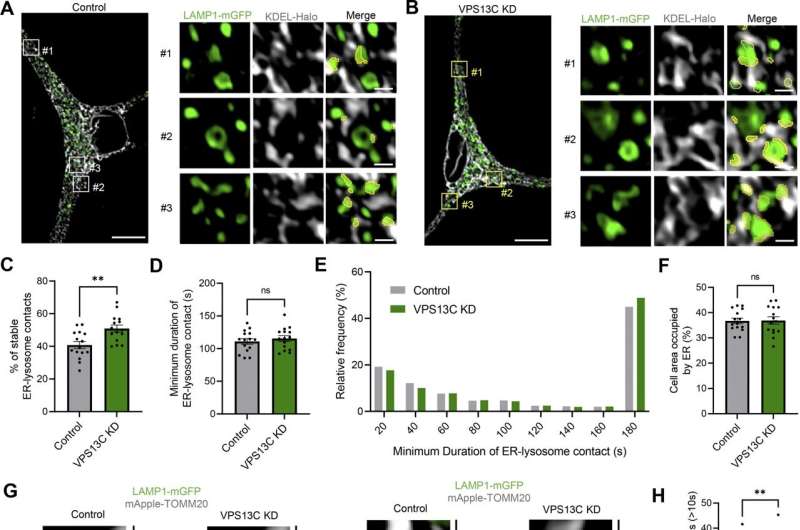This article has been reviewed according to Science X's editorial process and policies. Editors have highlighted the following attributes while ensuring the content's credibility:
fact-checked
trusted source
proofread
Mutation provides insights into mechanisms of neurodegeneration in Parkinson's disease

A mutated protein expressed in lysosomes may contribute to Parkinson's disease, according to a new Northwestern Medicine study published in the Journal of Cell Biology.
Parkinson's disease is the second-most common neurodegenerative disorder in the U.S., after Alzheimer's disease. The National Institutes of Neurological Disorders and Stroke estimates that as many as one million Americans live with Parkinson's. Motor dysfunction, a hallmark of Parkinson's, is caused by the progressive loss of dopaminergic neurons in the midbrain.
Lysosomes, organelles that function as recycling plants inside cells, have previously been associated with several neurodegenerative diseases, including Parkinson's disease, according to Dimitri Krainc, MD, Ph.D., the Aaron Montgomery Ward Professor and chair of the Davee Department of Neurology and senior author of the study.
A mutation in a protein known as VPS13C was linked to a rare form of early-onset Parkinson's disease that is severe and aggressive. However, exactly how that protein contributes to the disease has been unclear.
In the current study, Krainc and his collaborators used live-cell microscopy to investigate the role of VPS13C in regulating lysosomal function in dopaminergic neurons derived from human-induced pluripotent stem cells.
"We found that VPS13C regulates lysosomal health in dopaminergic neurons, the primary cell type that is affected in Parkinson's disease," said Krainc, who also directs the Simpson Querrey Center for Neurogenetics. "We further discovered that VPS13C regulates lysosomal maintenance through the interaction with a 'helper protein' called Rab10. When this protein is present on the lysosomal membrane together with VPS13C, it keeps lysosomes functional and healthy."
Mutations in VPS13C lead to its loss of function in patient-derived dopaminergic neurons, according to the study.
"The loss of VPS13C function that is seen in Parkinson's neurons causes lysosomes to become larger and form more contacts with each other. This disrupts the ability of lysosomes to move throughout neurons and respond to cellular stress," Krainc said. "Furthermore, lysosomes become less efficient in breaking down unwanted debris and other cellular components that need to be recycled which in turn leads to dysfunction and degeneration of dopaminergic neurons."
Now, Krainc and his colleagues hope to target VPS13C to restore lysosome dysfunction in Parkinson's disease, representing a potential new avenue toward treatment for the condition.
"Over the years. we have studied mutations in many genes that are linked to Parkinson's disease and observed that most of them indirectly or directly impact lysosomal function," Krainc said. "This converging mechanism provides a therapeutic opportunity to develop drugs that will improve lysosomal function and therefore help patients across different types of Parkinson's disease."
More information: Leonie F. Schrӧder et al, VPS13C regulates phospho-Rab10-mediated lysosomal function in human dopaminergic neurons, Journal of Cell Biology (2024). DOI: 10.1083/jcb.202304042

















